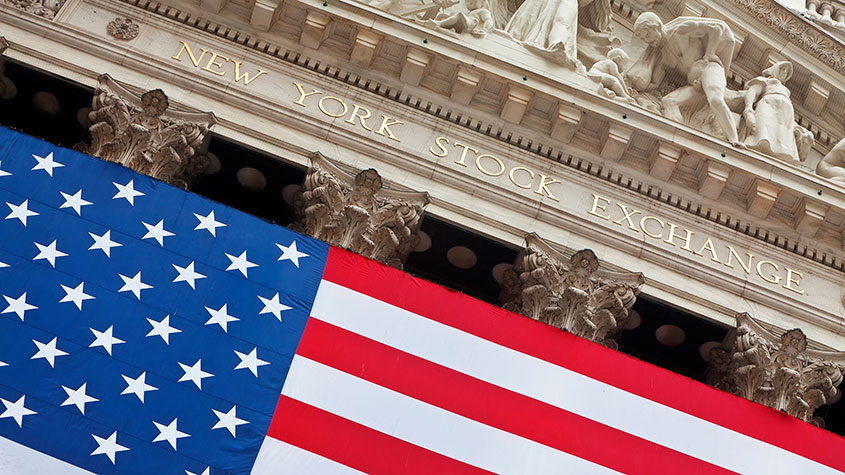The great rotation is firmly underway – what does it mean for you?
As investors move away from “jam tomorrow” stocks and back into “old economy” stocks that should benefit from the post-pandemic recovery, the tech-heavy Nasdaq index is selling off hard while the FTSE 100 holds its own. John Stepek explains what it means for you.


While we’ve been distracted by this week’s budget, things have been going a bit pear-shaped over in US markets.
It’s a continuation of the same problem we saw last week. Bond yields are going up, because investors think that the recovery will be better than expected. In turn, that will put pressure on the Federal Reserve to raise interest rates or tighten monetary policy in some way.
Yesterday, markets were hoping that Fed boss Jerome Powell would say something to calm them down. He tried. But at this stage, just talking isn’t quite enough.
MoneyWeek
Subscribe to MoneyWeek today and get your first six magazine issues absolutely FREE

Sign up to Money Morning
Don't miss the latest investment and personal finances news, market analysis, plus money-saving tips with our free twice-daily newsletter
Don't miss the latest investment and personal finances news, market analysis, plus money-saving tips with our free twice-daily newsletter
Here’s why “jam tomorrow” stocks are struggling
The tech-heavy Nasdaq index in the US has now entered correction territory. It’s down 10% since its most recent high, which came less than a month ago, on 12 February. The S&P 500, less reliant on tech, is down about 5% over the same period.
Over here in the UK, by contrast, the FTSE 100 is down by about 2% over the same period (though it peaked for the year back in January, since when it has fallen by about 4%).
What’s going on? Well, it’s what we’ve been discussing for a while now. Markets expect the economy to rebound hard now that we have vaccines and the global economy should re-open before the end of the summer and hopefully be well on the way to “normal” before the end of the year. As a result, they’re expecting prices to go up too. And if the recovery is strong enough, inflation might even become an issue again.
That’s all great news for the economy and for the “real” world. But it’s a bit trickier for the financial realm. If the economy is stronger, then central banks would normally be thinking about raising interest rates a bit. That’s not good for those markets which have become extremely expensive on the assumption that interest rates would stay low forever.
The worst-hit assets have been “long duration” plays, or what I’m constantly calling “jam tomorrow” stocks. Tesla, for example, is down by nearly 30% from its highest point this year. The electric-car maker is a stock whose valuation is predicated on hopes and dreams of a glorious future. But because that future is so far away, any change in the discount rate (the number you use to adjust the value of future earnings) has a much bigger effect on the present value of those future earnings than on some boring oil pumper like Exxon, say (you can read more about the mechanics of this in my earlier piece here).
So when Jerome Powell, the head of the Federal Reserve had a chat with the Wall Street Journal yesterday, the market was hoping that he’d say something reassuring, about how he wasn’t planning to even think about raising interest rates until and unless inflation was really going for it and America was at full employment.
The thing is, that’s basically what Powell said. He said: “We will be patient. We’re still a long way from our goals.” But the market still sold off. Why? Because he wasn’t specific enough.
The market will need to throw a bigger tantrum
Investors want the Fed to put a number on all this. They want to know that the Fed will act to keep rates down within certain parameters. In effect, investors are starting to price in earlier tightening than they’d previously expected. And that can’t help but have an effect on stocks (and bonds) that had been priced for a longer period of ultra-loose money.
Really, what they want is for the Fed to make an explicit commitment to something like yield curve control (where the central bank says that it simply won’t let long-term government bond yields rise above a certain rate). But the Fed hasn’t done that yet, and because the market is starting to believe that inflation will be higher than the Fed expects, they don’t think the Fed will hold out.
And the reality is that the bond market – I mean, you could call them “bond vigilantes” if you wanted though it’s a little melodramatic – will probably keep pushing yields higher until either investors decide that they’ve gone far enough for now (ie that they’re pricing in all the inflation they expect) or the Fed decides that enough is enough.
What’s likely to drive that? At the moment what we’re seeing is a shift from one sector of the market to another. As is clear from the figures above, the Nasdaq is having a tough time, but other markets aren’t doing too badly. Value is beating growth. Oil stocks are rallying hard in the face of full-on ESG adoption. The market is doing its usual thing – tipping the boat over just as everyone was looking over the side.
If this continues to simply be a rotation, the Fed may not need to even get involved. The problem is if it starts to spread to the financial plumbing. For example, maybe bond investors – normally the sober ones at the party – will panic and decide that it’s actually just been one big bubble and start selling hard rather than simply driving yields back up to “sensible” levels. I mean, there’s been a sniff of panic in the air recently – if that goes full blown, then the Fed might react.
Or of course, stocks might fall hard. That’s a distress call that central banks have previously struggled to ignore. As Eoin Treacy notes on FullerTreacyMoney.com, “with the S&P 500 down less than 5% from an all-time peak, the Fed has no incentive to act. When it is down 10% or even 20%, then we will see how sanguine the Fed is.”
In other words, we need to see another tantrum before the Fed feels justified in acting. While we wait for that, I’d just keep an eye on your watchlist, see if anything you want to buy becomes available more cheaply, and invest when it does. And I’d stick to the plan of value over growth, investing in energy stocks and financials, and opting for international over the US.
For more on all this (we’ve been talking about it for a while after all) make sure you subscribe to MoneyWeek – get your first six issues (plus a beginner’s guide to bitcoin) free here.
Get the latest financial news, insights and expert analysis from our award-winning MoneyWeek team, to help you understand what really matters when it comes to your finances.
John Stepek is a senior reporter at Bloomberg News and a former editor of MoneyWeek magazine. He graduated from Strathclyde University with a degree in psychology in 1996 and has always been fascinated by the gap between the way the market works in theory and the way it works in practice, and by how our deep-rooted instincts work against our best interests as investors.
He started out in journalism by writing articles about the specific business challenges facing family firms. In 2003, he took a job on the finance desk of Teletext, where he spent two years covering the markets and breaking financial news.
His work has been published in Families in Business, Shares magazine, Spear's Magazine, The Sunday Times, and The Spectator among others. He has also appeared as an expert commentator on BBC Radio 4's Today programme, BBC Radio Scotland, Newsnight, Daily Politics and Bloomberg. His first book, on contrarian investing, The Sceptical Investor, was released in March 2019. You can follow John on Twitter at @john_stepek.
-
 Autumn Budget tax changes: how is your generation affected?
Autumn Budget tax changes: how is your generation affected?The chancellor expects everyone to do their bit to boost the nation's finances but the tax burden is by no means shared equally
-
 Revealed: pension savers ditch investment trusts and favour passive funds
Revealed: pension savers ditch investment trusts and favour passive fundsDemand for investment trusts is cooling among self-invested personal pension (Sipp) customers, who are increasingly choosing money market funds, passive funds and individual shares
-
 Is it different this time for Japanese stocks?
Is it different this time for Japanese stocks?Analysis Nikkei 225 Index has jumped 19.8% this year, and there are signs the rally could continue.
-
 As China reopens, why pick an income strategy?
As China reopens, why pick an income strategy?Advertisement Feature Yoojeong Oh, Investment Manager, abrdn Asian Income Fund Limited
-
 Is Japan the best market to invest in now?
Is Japan the best market to invest in now?Opinion Japan puts Western economies to shame and offers good value for both equity and bond investors, says Max King.
-
 The highest yielding S&P 500 Dividend Aristocrats
The highest yielding S&P 500 Dividend AristocratsTips Dividends are a key component of investment returns in the long-term. A portfolio of dividend aristocrats is a great way to build wealth and a sustainable income stream.
-
 2023 will be a bumper year for stocks. Here’s how to play the rally
2023 will be a bumper year for stocks. Here’s how to play the rallyTips Dominic Frisby explains why he thinks the market rally could have further to run in 2023 despite macroeconomic headwinds
-
 A new dawn for Asian markets?
A new dawn for Asian markets?Advertisement Feature James Thom, Investment Manager, abrdn New Dawn Investment Trust plc
-
 China’s post-covid investment boom off to a slow start. Should you still invest in China?
China’s post-covid investment boom off to a slow start. Should you still invest in China?Advice Investors are no longer bullish on the China shop but the gloomy consensus on Beijing’s economy might be unfair. Should you invest in China?
-
 Stock market crash? This time it’s (slightly) different
Stock market crash? This time it’s (slightly) differentOpinion The bears expecting a stock market crash have got it wrong, says Max King.
